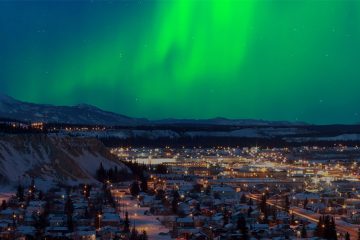Northern Lights and Northern Sights
Known as the most desolate and barren territory in Canada and often described as a lunar landscape, the far north of the True North Strong and Free boasts some of the most scenic geography anywhere. A visit to the upper reaches of the region will have you believing you’ve somehow been transported to another planet.
The Yukon, Northwest and Nunavut territories have a bounty of riches for frustrated world explorers. The area experiences some of the longest days in the northern hemisphere — 24 hours of daylight during the summer solstice — which should leave you plenty of time to look around.
When it comes to Northern Canada travel, this guide will help you make the most of your trip.
Best Destinations in Northern Canada
- Whitehorse: The Yukon’s largest city, Whitehorse harkens back to the days when there was “gold in them thar hills.” The Frantic Follies vaudeville-style revue will help you relive the city’s storied past.
- Dawson City: Follow the path of the intrepid Klondike Gold Rush explorers in this historic town.
- Yellowknife: Located on the north shore of Great Slave Lake is Canada’s northernmost city and probably the most challenging to access at any time of the year. But it serves as a gateway to the even more remote locales in the north — perfect spots for hunting or fishing retreats.
- Nahanni National Park: Located in the Northwest Territories, this World Heritage Site is home to Virginia Falls — a rushing waterfall twice the height of Niagara.
- Iqaluit: Inuit culture comes to the fore in Nunavut, Canada’s newest official territory. The capital city is only accessible by air or sea and is the main base for exploring Baffin Island.
- Baffin Island: The fifth largest island in the world, Baffin Island is home to Auyuittuq National Park and is a frozen wonderland of surreal scenery, hiking trails and wildlife.
- Kluane National Park: This Yukon park is home to ancient glaciers, caribou, grizzly bears, lynx and views that will take your breath away.
Best Time of Year to Visit
For the Best Weather
This is not the place to visit in mid-January — winter temperatures hover around freeze-your-fingers-off cold. July and August are the warmest months when the wildflowers and berries are flourishing (but so are the mosquitoes). The best time to visit is June, when the temperatures begin to rise but the bugs are not out in full force yet.
For Outdoor Activities
The ideal months for outdoor sports such as dog-sledding, hiking, kite-skiing, snowshoeing and more are April and May. This is when there is still plenty of snow on the ground, but the temperatures are warmer than the depths of winter. If fishing is your sport of choice, July is a great month to visit because the waters will still be cold and active but the weather will be enjoyable.
For Watching the Northern Lights
If watching the Aurora Borealis shimmer across the sky is on your bucket list, the best time to visit is between December and April. The shorter days bring darker skies and on these long, cold, clear nights you will have a better chance of seeing nature’s most spectacular light show.
How Much to Budget?
This is one of the most remote and difficult to travel places on Earth, so getting there will not be cheap. However, if you have the funds it is absolutely worth the experience.
If you don’t mind braving the elements you can save money by camping, which will cost around $15 to $25 per night. Hotel and motel rooms will cost around $60 to $100 per night, depending on the size of the town.
The prices will rise the further north you go. Also, food and gas costs are higher in the more remote communities as they have a harder time getting supplies.
If you're planning on visiting Zion National Park with your kids, these tips will help you make the most of your day, avoid crowds and see stunning sights.
Best Way to Get Around
There are two main roads heading into the Yukon from British Columbia — The Alaska Highway from Dawson Creek to Fairbanks and the Stewart-Cassiar Highway from Prince Rupert to Watson Lake.
The Stewart-Cassiar Highway offers better landscapes but the Alaska Highway is the more convenient option as it is serviced by Greyhound buses and has many campsites and motels along the way. There are also roads traveling to Yellowknife and Inuvik.
Keep in mind that if you are visiting during the winter the roads can close down at any time due to inclement weather. We never said Northern Canada tourism would be easy!
Another way to travel up north is via sea. There are a few different cruises that travel to the Canadian arctic and this will be the most comfortable and luxurious way to visit (although quite expensive).
It is also possible to fly from Churchill, Manitoba to many destinations in Canada’s north including Arviat, Chesterfield Inlet, Baker Lake, Coral Harbour, Repulse Bay, Rankin Inlet and Whale Cove.
